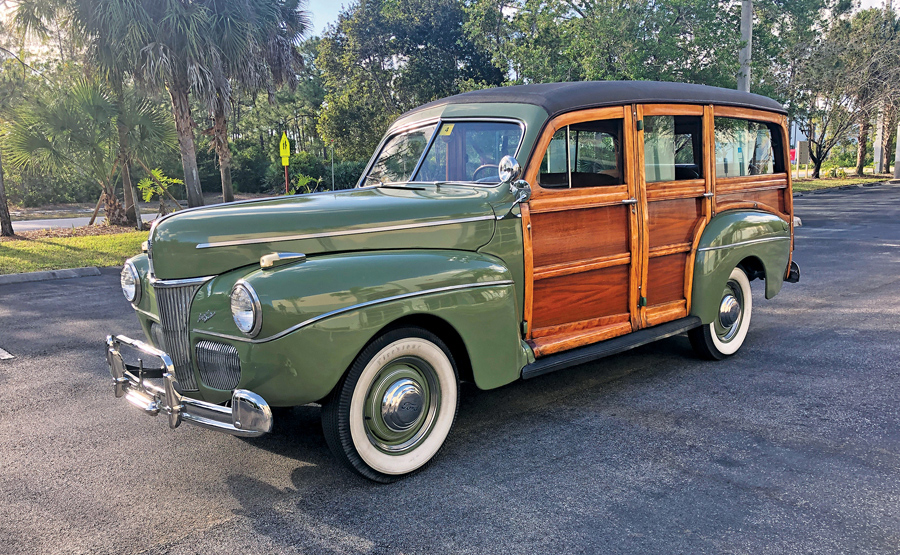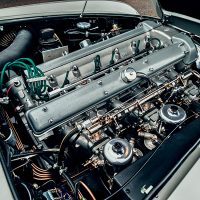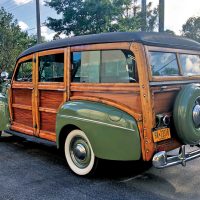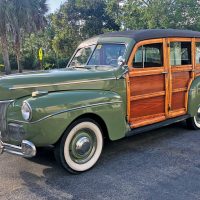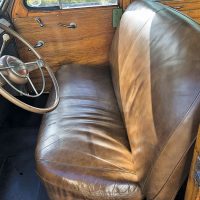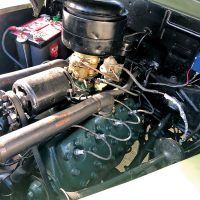SCM Analysis
Detailing
| Vehicle: | 1941 Ford Super Deluxe Station Wagon |
| Years Produced: | 1941–48 |
| Number Produced: | 9,485 (plus 6,116 Deluxe series) |
| Original List Price: | $1,015 |
| SCM Valuation: | $56,000 |
| Tune Up Cost: | $350 |
| Distributor Caps: | $20 (two at $10 each) |
| Chassis Number Location: | Stamped on the top face of the left frame rail, between the front suspension and radiator |
| Engine Number Location: | Upper surface of the flange facing the bellhousing |
| Club Info: | Early Ford V8 Club of America |
| Website: | http://www.earlyfordv8.org |
| Alternatives: | 1942, 1946–48 Ford Super Deluxe wagon; 1941–42, 1946–48 Mercury Eight wagon; 1940–42 Chevrolet Special series wagons |
| Investment Grade: | C |
This car, Lot 419, sold for $50,600, including buyer’s premium, during RM Sotheby’s Online Only Palm Beach, FL, auction on March 20–28, 2020.
In 1941, Ford introduced an all-new platform for their car production. This new platform carried the company through post-war 1948.
As part of Ford’s new-car platform in 1941, woodie wagons were also redone. This was the final year that both Deluxe and Super Deluxe wagon models were offered — the latter being the first Ford to list for over $1,000 since the 1929 Model A Town Car.
In addition, 1941 was the first year for the last generation of the all-wood-structure 4-door wagon. While the post-war, 2-door 1949–51 Ford and Mercury wagons still had real wood, it was mostly for looks on a basic steel shell. To get the full driving-a-cabinet experience, the 1941–48 Ford and Mercury wagons are it.
Surfin’ safari
Because many workers had to carpool to defense-industry jobs, a lot of 1941 Ford wagons survived into the post-war era. Some considered them old-fashioned, high maintenance, and another reminder of the war years.
However, the booming number of younger drivers during the 1950s embraced woodies for their easily hopped-up V8 engines, styling and practicality. Woodies were the car of choice for California surfers from the 1950s through the early 1960s.
During the later 1960s, this generation of woodie wagons graduated from surfboard-toting beaters to collectibles worthy of restoration. Any surviving by 1970 were all saved — barring insurance losses from calamities — and had either been preserved or restored to some level. You still see Ford woodies at California surf spots — but their owners tend to be much older and wealthier than the average surfer.
Our subject woodie appears to have been redone in fits and starts over the decades. This car never got a planned restoration. In particular, the fastener joints in the wood show a lot of distress and rot from the decades, and the electrical system is haphazard.
RM Sotheby’s listing mentioned that author and barn-find savant Tom Cotter owned the car at one time. Cotter is a well-known wagon fan, and his cars tend to be drivers rather than show-ponies.
A change in plans
Originally, this car was scheduled to be part of RM Sotheby’s live auction in West Palm Beach, but the COVID-19 pandemic changed the world in a few days. RM Sotheby’s quickly canceled the live auction and turned it into an online-only sale.
There was another 1941 Ford Super Deluxe woodie on the docket.
Lot 360, finished in Washington Blue, benefited from a professional restoration in 1985 and won AACA National First Place awards.
Despite some aging of the chrome plating along with some paint nicks that have been touched up, Lot 360 is still in great condition 35 years later. While it is in better condition than our featured wagon, it only sold for a few bids more, at $53,900.
Frankly, I’d have bid on that example and not bothered with our featured car (then again, I’m a sucker for Washington Blue).
Location, location, location?
Our featured wagon was already on site in West Palm Beach before the auction was changed to online only. The other car was sitting in New York state. As such, shipping costs can be a factor. For a bidder in Florida, shipping costs are markedly lower on our subject car. The opposite would also be true for bidders in New England. Yet for someone on the West Coast, it’s probably a draw.
The cost of shipping may have helped — or hurt — the price of our subject woodie.
In recent years, the market for woodies has softened. However, it may be more accurate to say that the woodie market moved to driver-grade cars instead of concours lawn ornaments.
I get the feeling that the price on our subject woodie was a product of antsy bidders stuck at home with nothing better to do than sit at the computer and bid on cars. Would it have done better or worse with a live, on-site auction as part of the mix? It’s hard to say one way or the other, but for the reality of this sale, I’ll call it better sold than bought.
